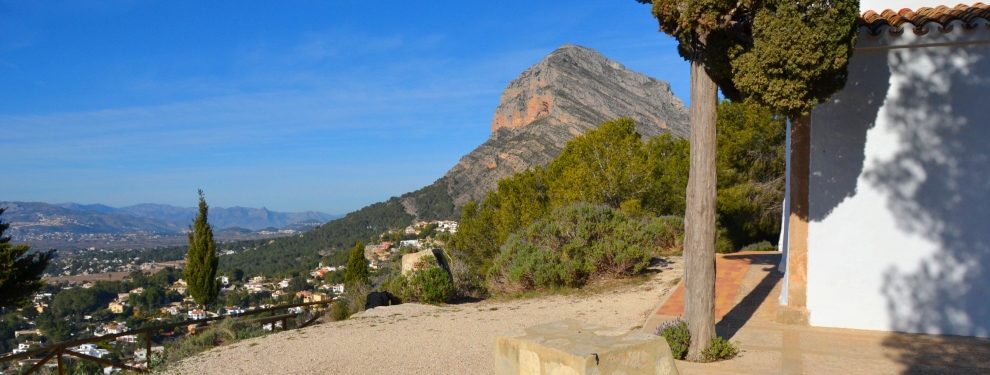
The chapel de Santa Llúcia sits on top the conical hill of Tossal de Santa Llucía, a 165m summit affording spectacular views in almost every direction. In my opinion, the situation offers one of the best locations to photograph the nearby mountain of Montgó, rising dramatically to the north-west, whilst on clear days the island of Ibiza, over 90 kilometres distant, can be made out as a dark but obvious smudge on the horizon to the east.
Route Details
- Length: 2,4 kilometres
- Ascent: 240m
- Time: 1 hour
- Grade: Low
- Equipment: Sturdy footwear, water, camera.
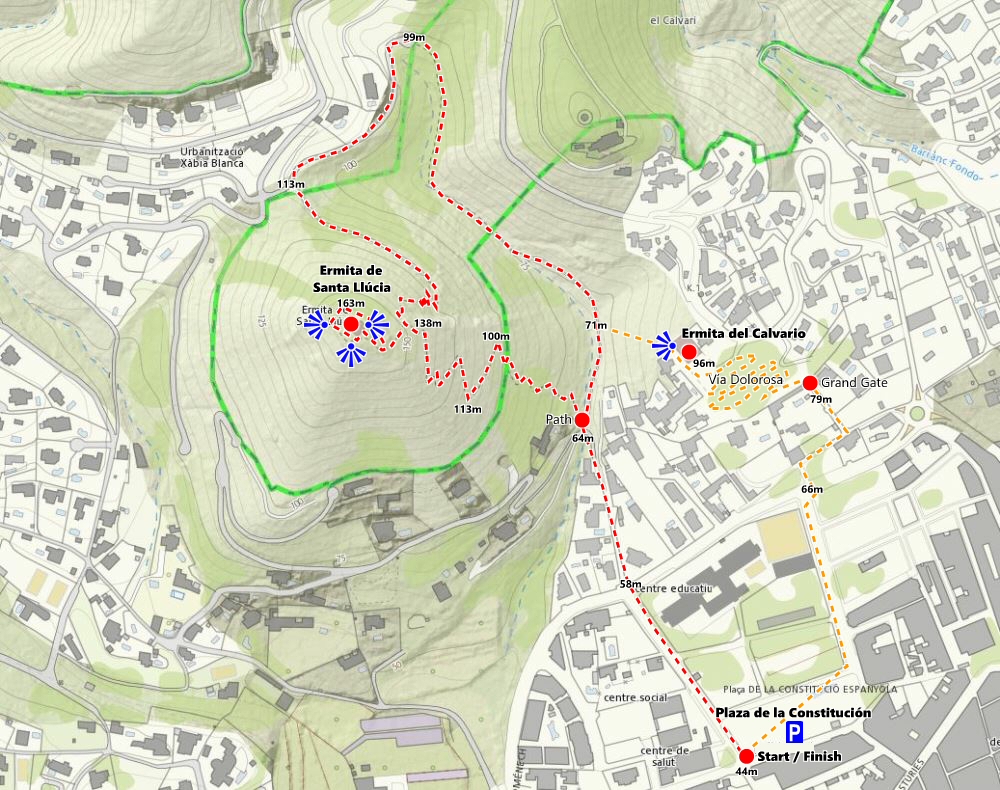
There is ample parking in the underground car-park underneath the wide open Plaza de la Constitución, a square with a number of small bars which can offer suitable refreshment both before and after the walk to the chapel de Santa Llúcia. The hillock of Santa Llúcia is the obvious mound just a few hundred metres to the north of the square; in the background, the mountain of El Montgó mounts a permanent guard over the town.
The route heads towards this hill, climbing steadily up Calle de Rafael Echague with the Parque Montañer to your right and the modern ‘Conservatorio de Música’ on your left. At the top of the road, cross the often busy Avenida Angel Doménech by the pedestrian crossing; there is a tosca stone cross on the opposite side of the road, a helpful marker along with the white-and-green paint on the roadsign. To the left of the cross, the Camí de Santa Llúcia leads to the bottom of the path to the top of the hill.
After about 150m or so, there is a small rough expanse of land often used as a car-park; you can opt to start the route from here but you leave your car at your own risk. There is a wooden information board which is worth a look and the path is clearly marked to the right of it next to the white marker for the Ermita de Santa Llúcia.
After a gentle ascent of just a few metres, the next few hundred metres require plenty of puff and determination as the path winds steeply through the trees until it becomes a little gentler as it continues a broad zig-zag up the hill. Across the ravine is the blue-domed Ermita de Santo Cristo del Calvario which can be reached by a small path which climbs up the hillside and this is an option for the return journey. Soon the rough path reaches another set of signs and the white-walled ermita can just be seen through the trees above. Turning left, there’s a final steep ascent along a concreted path to the top.
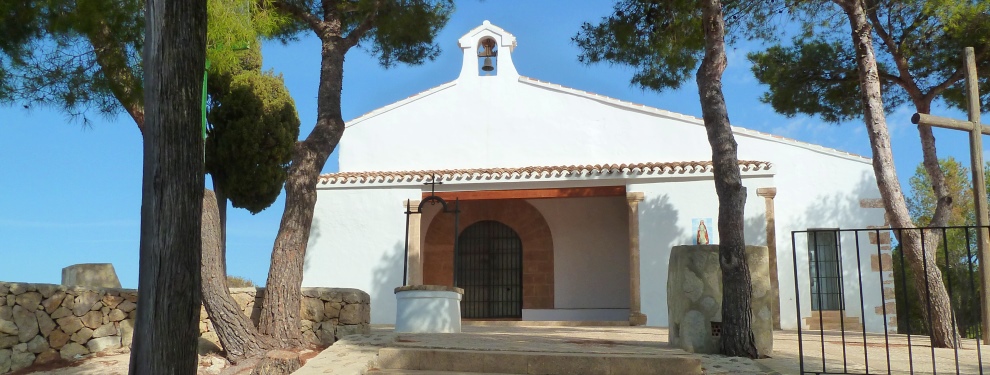
The existing building was constructed in the 17th century and consists of a single rectangular nave with a gable roof supported by two tosca stone arches, a style typical of the “conquest chapels” found all over the region. Additions were made at a later date, including the chapel rooms and the small front porch.
In 2004 a new bell replaced the original, thought to be some 500 years old and moved to the chapel from the town’s old cemetery during the 1940s; the old bell is now located in the town’s Museum of Archaeology and Ethnology in Carrer de Primicies. Take a look inside the verandah; to the right there is a grid of colours and symbols – if anyone knows what it means, please let us know!
The view over the valley of San Bartolomé is quite stunning whilst the Puig de Llorença and its communication towers clearly visible to the south whilst the serrated ridge of the Sierra Bernía is just about visible over the low hulking Sierra de Seldetes. To the east, through the trees, the view extends down the port and to the end of Cabo de San Antonio with its lighthouse. And, to the north-east, there is an impressive view of El Montgó and its “eye”, the huge cavity of La Cova Ampla.
A wide path passes through the trees to the left of the chapel, a circular route used mainly by the pilgrims who carry the images of Santa Llúcia and Santa Barbara on their shoulders around the chapel in December. This path is a pleasant little stroll around the top of the hill and there is another great view of El Montgó through the trees. Continuing around the chapel, the path emerges from the trees on the other side and rejoins the main path.
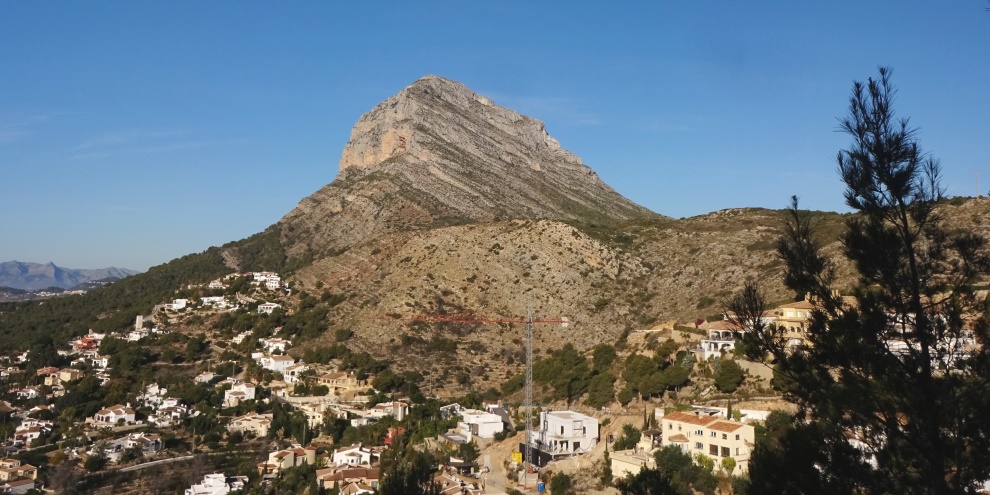
There are two options for the return. The quickest is to retrace your steps and descend via the same path but there is an option to complete a circular route by following the concrete path which zig-zags down the northern flanks of the hill below crags used to teach basic rock-climbing. At the bottom of the descent, a rough but wide track leads to a road; there are more great views of El Montgó. At the end of the track, turn right, heading downhill and perhaps pausing to glance back at the route of the descent before the tarmac ends abruptly and the way ahead continues down the wooded ravine.
The path is initially quite rough, littered with the debris of flooding during wetter periods when the rainwater rushes off the slopes and into the gulley so care needs to be taken to avoid an inconvenient twisted ankle. Eventually the path becomes a gentle stroll with the Ermita del Santo Cristo de Calvario perched on the hillside in front of you.
Some 200m before the return to the start of the ascent, a narrow steep track leads up the hillside to the blue-domed church and this is an option to take as it affords a great view of the hill of Santa Llúcia. Otherwise continue forward back to the olive tree and the start of the marked path and retrace your steps back to the Plaza de la Constitución.
OPTIONAL: La Emita del Calvario
Take the narrow but steep path up to the blue-domed chapel; you’ll pass along its side to the open plaza at the front. There is a decent view of the Santa Llúcia hill and the route that winds its way up its eastern flank.
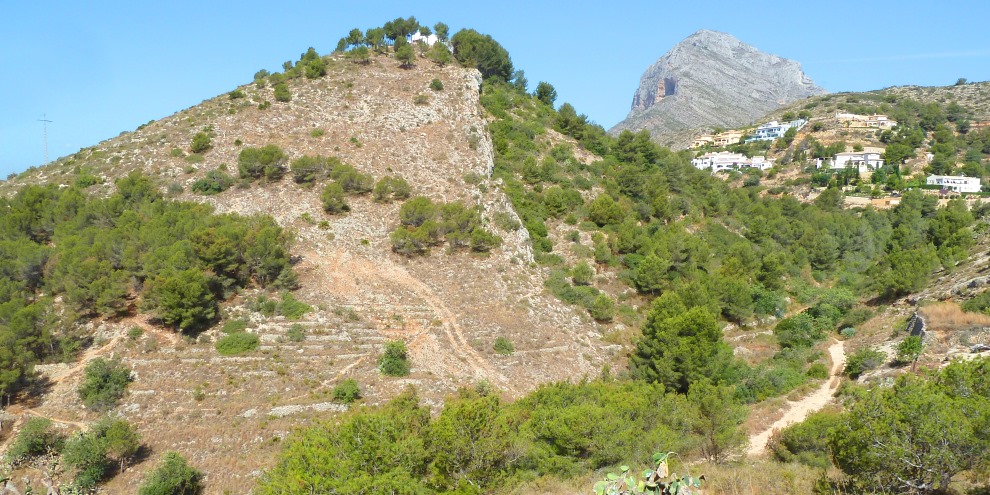
To the south of the plaza, a wide path winds its way down to a large and remarkable tosca archway; this is the “Via Dolorosa” with fourteen “Stations of the Cross” depicting the final hours of Jesús Christ. During the Jesus Nazareno celebrations in the spring, devotees will carry the sacred image of Jesús Nazareno high on their shoulders along this path accompanied by many worshippers carrying long candles.
Through the archway, Calle Finisterre descends down towards the town; at the bottom of the hill, turn right and follow the road until it ends at a set of steps. Take these and continue back towards the tosca stone cross and retrace your steps back to the Plaza de la Constitución.
RELATED LINK: Fiesta Santa Llúcia – December 13
“No one saves us but ourselves. No one can and no one may. We ourselves must walk the path.”
BUDDHA

